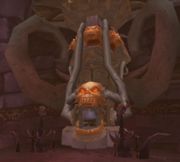Expertise is one of the more confusing stats a DPSer has to look at, in my opinion. Less so than Armor Penetration, which seems to be going through changes daily. So what does it do, exactly? Expertise reduces the chance that a mob can parry/dodge your attack by a % depending on how much you have of the stat. To be fully “soft-capped” (read: pushing dodge off the table) you need 26 expertise (not rating). Since bosses can’t parry from behind, you don’t have to worry about that as a DPSer. It’s called a soft cap rather than a hard cap because a boss’s parry chance is something ridiculous like 18-19% and it’s simply not worth getting that much expertise. Different specs value this stat differently, and for different reasons. Let’s start off with Frost, because I love it so. Also, I’m only going to deal with 2-handed specs in this post because I have little to no knowledge about DWing and expertise.
Frost in Blood Presence
None of the theoretically highest DPS rotations being bandied about on EJ currently use Blood Presence, but I imagine at some point in the future it will rise again. In any case, when examining expertise, which only affects melee strikes (Frost Strike and Rune Strike excluded), the first step is to look at how many of a given spec’s abilities are actually affected by expertise. For Frost, these are (%s next to ability names are how much of total DPS they comprise in a fight)*
- Obliterate (~15%)
- Auto-attack (~20%)
- Blood Strike (~4%)
- Plague Strike (if using it in a rotation) (~3%)
*See here for the source of my numbers
So for Frost, a total of around 42% of your damage comes from abilities (or auto-attacks) affected by expertise. If you’re running in BP, it can be extremely detrimental to have an attack or two dodged, since you will often be low on GCDs (global cooldowns) and have little room to redo failed attacks. As a result, expertise is fairly valuable for this spec and worth considering as a factor in gearing up.
Frost in Unholy Presence
Expertise loses a great deal of its value when running in Unholy Presence due to the fact that you have so many more GCDs, and are often left with 1-2 seconds now and then with nothing to do. If you get dodged or parried, you lose much less time than in Blood Presence, and so expertise loses some of its value for UP rotations. Keep in mind, however, that your white damage, a fairly major component of damage, can’t recover damage lost to parries, so with more expertise your auto-attack damage will go up, if only slightly.
Unholy in Blood Presence
Unholy, similar to UP Frost, has more GCDs open than some other DPS rotations. This is largely due to spamming Scourge Strike, a two-rune ability rather than using lots of single rune attacks. Nevertheless, let’s look at how much of an Unholy DK’s damage comes from weapon strikes. Same format as above.
- Scourge Strike (~20%)
- Melee (~20%) (~22% with Necrosis)
- Blood Strike (~5)
- Plague Strike (~3.5%)*
- Blood-Caked Strike (~2%)
*See here for source.
So that’s around 52% of total damage, with the rest coming from Death Coils, Unholy Blight, DnD, diseases and Wandering Plague. Necrosis adds value to expertise because it’s always going to be 20% of your white damage, which as I said earlier scales with your pre-soft cap expertise. However, due to having a relatively loose rotation, capping expertise isn’t essential.
Blood in Blood Presence
Blood is in a similar situation to Frost when run in Blood Presence. Since Heart Strike is a single-rune ability, and the most-used in a Blood spec, GCDs are limited. It’s more valuable to Blood, however, due to the larger amount of physical damage that it puts out.
- Heart Strike (~24%)
- Melee (~21%) (+~3% for Necrosis)
- Death Strike (~11%)
- Plague Strike (~3%)
- Blood-Caked Strike (~3%)*
*See here for source.
So that’s around ~56% of damage. Since you’re using a lot of Heart Strikes, and running in Blood Presence, it’s of paramount importance to get as close as possible to the expertise cap so your rotation doesn’t get screwed up.
Expertise vs. Strength
Some people say that expertise is a preference call. Do you prefer knowing for sure that all your attacks will land, and so as a result have an easier rotation? Or would you rather hit harder when you aren’t getting dodged? When considering gear upgrades with or without expertise, it’s somewhat personal, but with regards to gemming you should always go for strength. Basically, don’t go too far out of your way for expertise unless you’re extremely low on it (below 15-ish you’ll get dodged a lot). Also, as a DK strength affects the damage of everything you do, where expertise only the physical stuff, which makes up somewhere around half (less for Frost) of your total damage. It also loses all value after the soft cap since you should always, always be standing behind a mob to DPS it. (Mobs can’t parry from behind.)
In closing, a sample of my artwork, somewhat related to this posting.

It certainly is.


 Morbidity isn’t all you crack it up to be
Morbidity isn’t all you crack it up to be Dirge, on the other hand…
Dirge, on the other hand…
